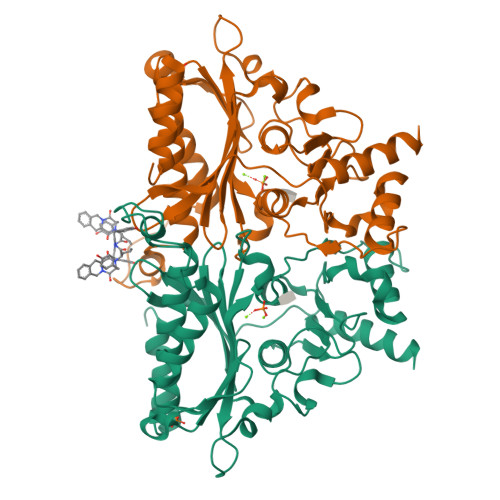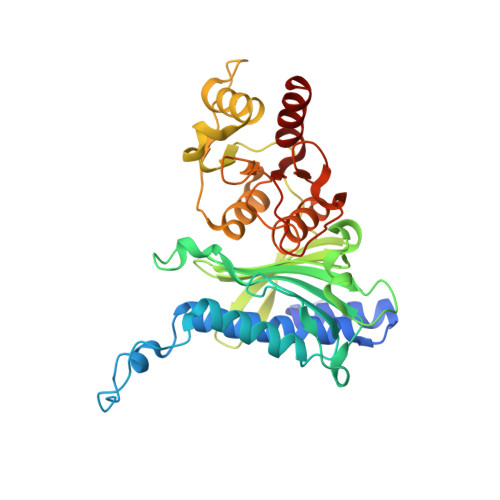Inhibition of fructose-1,6-bisphosphatase by a new class of allosteric effectors
Choe, J.Y., Nelson, S.W., Arienti, K.L., Axe, F.U., Collins, T.L., Jones, T.K., Kimmich, R.D., Newman, M.J., Norvell, K., Ripka, W.C., Romano, S.J., Short, K.M., Slee, D.H., Fromm, H.J., Honzatko, R.B.(2003) J Biological Chem 278: 51176-51183
- PubMed: 14530289
- DOI: https://doi.org/10.1074/jbc.M308396200
- Primary Citation of Related Structures:
1Q9D - PubMed Abstract:
A highly constrained pseudo-tetrapeptide (OC252-324) further defines a new allosteric binding site located near the center of fructose-1,6-bisphosphatase. In a crystal structure, pairs of inhibitory molecules bind to opposite faces of the enzyme tetramer. Each ligand molecule is in contact with three of four subunits of the tetramer, hydrogen bonding with the side chain of Asp187 and the backbone carbonyl of residue 71, and electrostatically interacting with the backbone carbonyl of residue 51. The ligated complex adopts a quaternary structure between the canonical R- and T-states of fructose-1,6-bisphosphatase, and yet a dynamic loop essential for catalysis (residues 52-72) is in a conformation identical to that of the T-state enzyme. Inhibition by the pseudo-tetrapeptide is cooperative (Hill coefficient of 2), synergistic with both AMP and fructose 2,6-bisphosphate, noncompetitive with respect to Mg2+, and uncompetitive with respect to fructose 1,6-bisphosphate. The ligand dramatically lowers the concentration at which substrate inhibition dominates the kinetics of fructose-1,6-bisphosphatase. Elevated substrate concentrations employed in kinetic screens may have facilitated the discovery of this uncompetitive inhibitor. Moreover, the inhibitor could mimic an unknown natural effector of fructose-1,6-bisphosphatase, as it interacts strongly with a conserved residue of undetermined functional significance.
Organizational Affiliation:
Department of Biochemistry, Biophysics, and Molecular Biology, Iowa State University, Ames, Iowa 50011, USA.





















